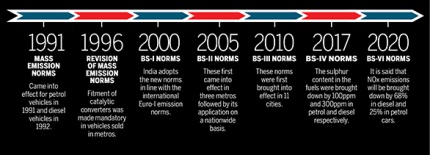Context
-
Ministry of Road Transport and Highways vide GSR 728 (E) has notified mass emission standards for E 12 (12% Ethanol with Gasoline) and E15 (15% Ethanol 12 with gasoline) fuels.
Key Details about the Mass Emission Standards
- Mass Emission Standards will enable the automotive industry to manufacture E12 and E15 compliant motor vehicles
- The draft rules further to amend the Central Motor Vehicles Rules, 1989, were published as required under sub-section (1) of section 212 of the Motor Vehicles Act, 1988.

- After considering the objections and suggestions received from the public in respect of the said draft rules, the Central government in exercise of the powers conferred by section 110 of the Motor Vehicles Act, 1988 (59 of 1988), made the following rules further to amend the Central Motor Vehicles Rules, 1989:
- These rules may be called as Central Motor Vehicles (25th Amendment) Rules, 2021.
- The compatibility of vehicle to level of ethanol blend of E12 or E15 or E20 or E85 or E100 shall be defined by the vehicle manufacturer and the same shall be displayed on vehicle by putting a clearly visible sticker after serial number.
- For the bi-fuel vehicles, the reference gasoline fuel shall be as per E5 or E10 or E12 or E15 as declared by the manufacturer during approval.
- Emission tests for CMVR compliance, shall be carried out as per AIS 137 as applicable and as amended from time to time. Vehicles manufacturer shall submit the vehicle to the test agencies referred under rule 126, for CMVR compliance.
Back to Basics
About Ethanol
- Ethanol, an anhydrous ethyl alcohol having chemical formula of C2H5OH, can be produced from sugarcane, maize, wheat, etc which are having high starch content. In India, ethanol is mainly produced from sugarcane molasses by fermentation process.
- Ethanol can be mixed with gasoline to form different blends.
- As the ethanol molecule contains oxygen, it allows the engine to more completely combust the fuel, resulting in fewer emissions and thereby reducing the occurrence of environmental pollution.
- Since ethanol is produced from plants that harness the power of the sun, ethanol is also considered as renewable fuel.
Ethanol Blended Petrol Programme (EBP Programme)
- Ethanol is an agro-based product, mainly produced from a by-product of the sugar industry, namely molasses. In years of surplus production of sugarcane, when prices are depressed, the sugar industry is unable to make timely payment of cane price to farmers.
- The Ethanol Blending Programme (EBP) seeks to achieve blending of Ethanol with motor sprit with a view to reducing pollution, conserve foreign exchange and increase value addition in the sugar industry enabling them to clear cane price arrears of farmers.
- Ethanol Blended Petrol (EBP) programme was launched in January, 2003.
- The programme sought to promote the use of alternative and environment friendly fuels and to reduce import dependency for energy requirements.
- The Central Government has scaled up blending targets from 5% to 10% under the Ethanol Blending Programme (EBP).
- The procedure of procurement of ethanol under the EBP has been simplified to streamline the entire ethanol supply chain and remunerative ex-depot price of ethanol has been fixed.
- To facilitate achieving of new blending targets, a “grid” which networks distilleries to OMC depots and details quantities to be supplied has been worked out.
- State-wise demand profile has also been projected, keeping in view distances, capacities and other sectoral demands.
Environment and Biodiversity Current Affairs UPSC 2022: Click Here
